
If you are wondering how to plan a final celebration that is meaningful and that expresses the individuality of the person who died, then here are a few ideas to create an especially healing funeral tribute.

If you are wondering how to plan a final celebration that is meaningful and that expresses the individuality of the person who died, then here are a few ideas to create an especially healing funeral tribute.

There are many practical benefits to funeral preplanning – like saving money, qualifying for Medicaid, and having funeral funds set aside to pay for everything – but did you know there are also emotional benefits? And let’s be honest – the emotional part of death is the hardest part. So, if you’re on the fence about planning ahead for your funeral wishes, take a look at these 5 emotional benefits that preplanning can give your family during a time of grief and loss.

After the death of a loved one, it falls to the surviving family members to plan the funeral with the help of a local funeral home. If there’s no advance preparation, that means the family will have to answer 130+ questions in a short period of time. On top of that, they will have to come up with the funds to pay for the funeral, and most families aren’t prepared to take on that kind of unexpected financial responsibility. But with funeral preplanning, you can reduce the stress your family will feel by answering all the questions ahead of time. And if you want, you can set aside funds to cover all the costs.

Have you ever had to make an important decision without first speaking to your spouse? It’s hard, and there’s a lot of uncertainty. That’s what happens when a loved one doesn’t leave instructions about their funeral wishes. When faced with planning a loved one’s final tribute, surviving family members often feel deeply uncertain and doubt the decisions they made.
Was cremation the right choice? Should we have had a viewing to say our last goodbyes? Could we have done more to personalize the service? By putting your funeral wishes in writing, you remove these feelings of indecision. Instead, your family can honor your life the way you want and feel good about it.

What happens when everyone is feeling stressed and no one knows what to do? Stress increases, opinions come out, and arguments begin to simmer. When it’s unclear how to proceed with the funeral plans, surviving family members may begin to disagree on how to proceed.
For example, your son may prefer burial while your daughter thinks cremation is best. Or your spouse is worried about expenses while your children want a big extravagant event. With 130+ questions to answer, there’s a lot of room for argument and hurt feelings. However, when your preferences are clearly outlined with funeral preplanning, your family knows what you want. They can then use that roadmap to honor your life and legacy.

It may sound weird, but funeral preplanning can actually give your family a sense of stability and control. When a loved one dies, routines are disrupted, and everything feels out of sync, upended, out of control. But when there’s a plan in place, a feeling of stability returns. They don’t have to wade through a sea of uncertainty without a compass. Instead, your advance funeral plan becomes an anchor amidst the whirlwind of planning. The first days following a loss are the hardest, and that sense of stability can soothe emotions and calm fears.

Lastly, funeral preplanning can bring peace of mind to you and your family. For your family, they can rest easy, knowing that you’ve taken care of everything. The selections have been made. The music and venue chosen. The vital statistics are already on file at the funeral home. All your family has to do when the time comes is to choose a date and time. And you can rest in the knowledge that you’ve done everything you can to care for your family and make a difficult experience a little bit easier. That’s a beautiful gift.
Before we go, one more thing.

One of the benefits of planning ahead for your funeral wishes is that it gives you time to consider all the options and choose what best fits your personality and preferences. As you plan, you’ll definitely want to work with a reputable local funeral home. The funeral director can help you understand your options and act as a resource throughout the advance planning process.
However, also consider inviting your family into the planning process. Yes, you are putting a plan in place to help them, but they can also help you. You may think that a simple burial with no service would be easiest, but your family may want to have a funeral service and invite friends and extended family to pay their respects. The funeral is about your life, but it’s also about your family’s emotional needs. Consider listening to what they think and incorporating some of those ideas into your funeral wishes.

Each person deserves a final ceremony that is as unique as their individual life. These ceremonies should reflect the person’s unique personality and honor the memories they made during their lifetime. Here are a few ways you can create a personalized final farewell celebration.

If you need to qualify for Medicaid coverage for long term care, you may be trying to think of smart ways to spend down your assets. Burial plans can be set up as exempt assets so that they are not counted when applying for Medicaid coverage. This way, you are able to preserve some assets that your family will need one day.
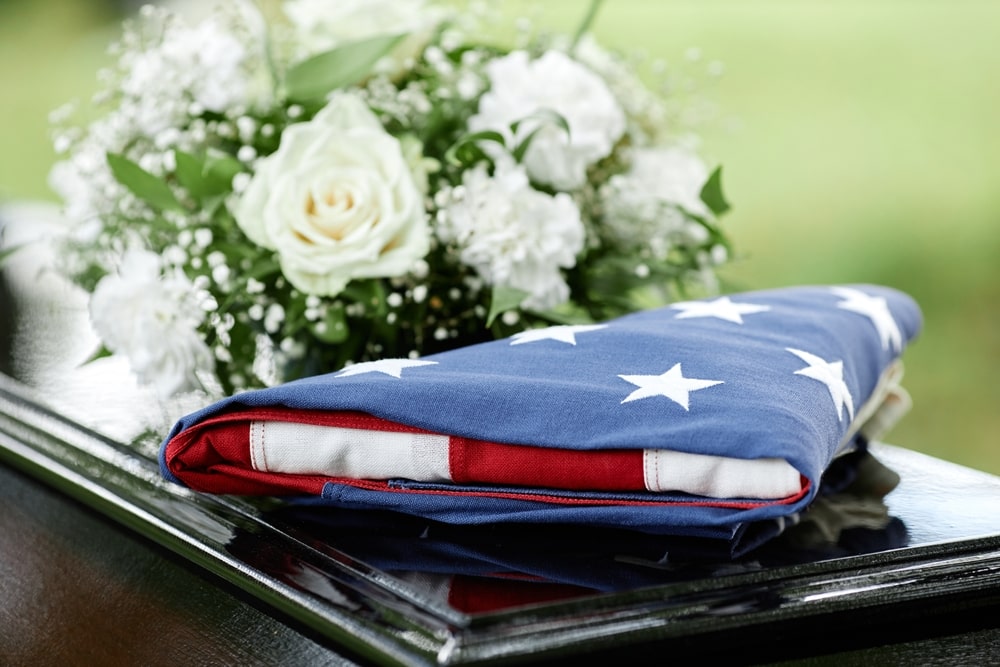
Did you know that the government provides burial benefits for eligible veterans?
Every year, many veterans miss out on receiving these burial benefits because they don’t know what’s available to them. But with a little advance planning, you can ensure that you and your family receive the burial benefits you are entitled to. To learn what burial benefits you’re eligible for, you can contact your local VA office.
Not sure where to start? Here is a checklist to assist you in planning ahead as a veteran:
To download a PDF version of this checklist, click here.
The veteran’s DD Form 214 or equivalent is required to access burial benefits. This form identifies the classification of discharge. If a veteran has anything less than a general discharge, he or she may not qualify for burial benefits.
To make applying for burial benefits easier, make sure your next of kin knows where you keep your DD Form 214. If the DD Form 214 is misplaced or lost, contact Veteran Affairs or your local Veteran Service Officer to request a replacement form.

Normally, your funeral director will contact the honor guard of the veteran’s military branch if military honors are requested. In addition, one burial flag will be presented to the next of kin. Make a note of to whom the flag should be presented and which military honors you wish to receive.
While the VA will not pay for cremation or funeral costs in full, they may pay the next of kin a burial allowance. Your eligibility depends on your circumstances and whether you qualify. To make sure funeral costs are covered, you should make arrangements with a funeral home.
A veteran buried in a national cemetery is eligible to receive, at no cost to the family, an opening and closing of the grave, perpetual care, government-furnished headstone or marker, one burial flag, a Presidential Memorial Certificate, and a grave liner.
Also, burial benefits are available for spouses and dependents buried in a national cemetery. These benefits include burial with the veteran, perpetual care, and the spouse or dependent’s name and date of birth and death inscribed on the veteran’s headstone, at no cost to the family. Eligible spouses and dependents may be buried, even if they predecease the veteran.
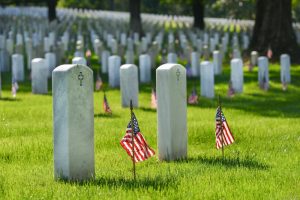
If you are requesting burial in a national cemetery, contact the National Cemetery Administration to make burial arrangements. The funeral director or person making arrangements will send all discharge documentation to the National Cemetery Scheduling Office. For more information, visit the National Cemetery Administration website. Burials at Arlington National Cemetery are reserved for military retirees, Medal of Honor recipients, or service members who die on active duty.
Burial benefits may also be available at your local state cemetery, including opening and closing of the grave, perpetual care, grave liner, and the setting of the government-furnished headstone or marker. In addition, an eligible veteran buried in a state cemetery is still entitled to receive a government headstone or marker, one burial flag, and a Presidential Memorial Certificate, at no cost to the family.

Check with your funeral director for more information about burial benefits that may be available for eligible dependents. Additionally, your funeral director can inform you about any fees associated with burial.
Veterans buried in a private cemetery may be eligible to receive a government-furnished headstone, a marker or medallion, one burial flag, and a Presidential Memorial Certificate, at no cost to the family. Spouses and dependents buried in a private cemetery are not eligible for any VA benefits. To determine eligibility, contact your local Veteran Service Officer.

For eligible veterans, the VA provides burial allowances to help offset an eligible veteran’s burial or cremation and funeral costs. However, these burial allowances typically do not cover the full cost. To receive a burial allowance, you must meet at least one of the following conditions:
Contact your VA office to determine if you are eligible for a burial allowance.
Still have questions? Check out our Veterans’ Burial Benefits FAQ for more information.

Most funeral homes are staffed by hardworking, caring, and compassionate people. But every once in a while, you might come across a funeral home that does not have your best interests in mind. So, how can you identify the funeral homes you should avoid? Let’s discuss several warning signs you can look out for as you choose a funeral home partner.

Unless you live in a small town, you likely have more than one choice of funeral home. And it’s up to you to decide which one you want to work with. As you thoughtfully consider your options, look out for the following warning signs.
By law, every funeral home is required to keep a General Price List (GPL) updated and available to consumers. That means you! The Federal Trade Commission set the Funeral Rule in place back in 1984 to protect you from possible scams or unfair pricing. Whether you’re preplanning or have suffered a recent loss, if the funeral home doesn’t want to give you their GPL, that’s a red flag. When you pick up the GPL, the funeral home may want to briefly discuss their pricing with you and answer your questions, but they should NEVER refuse to give it to you.

There are many ways a funeral home can exhibit a lack of transparency. Do they only show you a limited number of caskets or urns? Do they give you vague numbers or generally avoid specific answers to your questions? Are they asking you to pay without an explanation of services? These are red flags that the funeral director could be acting dishonestly. A reputable funeral home will review ALL of your options for services and merchandise. Plus, they will give you an itemized breakdown of costs.
Our third warning sign relates to how the funeral director talks about services and merchandise. Do they want you to pay for a protective casket even though you’ve chosen cremation? Are they pushing you to add services you don’t want? Are they saying embalming is required? Good funeral homes will present you with the options and offer suggestions based on their experience, but they will allow you to decide what’s best for your family. So, if you feel like the funeral director is aggressively trying to steer you toward certain decisions, that’s a red flag.

After losing a loved one, you’re already in a state of heightened stress. Regardless of what the funeral director may say, you have time to make decisions about honoring your loved one’s life. If they start telling you that every decision needs to be made RIGHT NOW or that you’re taking too long, that’s a red flag. The best funeral directors will take all the time you need. They will sit with you, listen to you, and do everything possible to help your family create a unique and meaningful final tribute.
“Emotional overspending” is a real thing. It often happens when the deceased doesn’t leave behind instructions regarding their funeral wishes. The surviving family members, not knowing what to do, may decide to go all out and buy “only the best” for their loved one. A dishonest funeral director will take advantage of the family’s uncertainty and make them feel guilty if they don’t buy the most expensive options. The funeral director is there to guide your experience, not dictate your decisions. If they start to guilt trip you for choosing a less expensive option, that’s a red flag.

The funeral profession is closely intertwined with the most difficult human experience: the death of a loved one. When choosing a funeral home, you need caring, sympathetic people alongside you. If the funeral director is acting inconsiderate, unkind, impatient, or simply disinterested or aloof, that’s a red flag. The last thing you need following the death of a loved one is to deal with a difficult person. Good funeral homes will employ knowledgeable, compassionate people who want to help you through each step of the funeral planning process.
At funeral homes that practice good customer service, the goal is to make the funeral planning process as simple and easy for you as possible. That means they should be accommodating and easy to work with. However, if your interactions with the funeral home are difficult or frustrating, that’s a red flag. For example, do they reschedule appointments without advance notice? Are they impossible to get ahold of? Do they avoid answering your questions? Never return your calls? These behaviors shouldn’t be ignored.

Now that we’ve covered 7 warning signs to look out for, let’s talk about several ways you can avoid ending up at a dishonest funeral home in the first place.
None of us like to think about death ahead of time. But if you want to make sure you and your family aren’t taken advantage of, you should familiarize yourself with the funeral homes in your area long before you need their services.
You can do that in several ways, including:

With all the regulations and guidelines set in place, the odds are excellent that most of the funeral homes in your area are run by good, caring people who are providing a necessary and much-needed service. But there are a few bad apples out there, and it’s good to identify them.
For additional information, check out Top 10 Characteristics to Look for in a Funeral Home or Top 11 Qualities to Look for in a Funeral Director.
Armed with these 7 warning signs, you can more confidently choose a funeral home partner who will focus on meeting your needs, answering your questions, and ensuring that you and your loved one are treated with respect, dignity, and the utmost integrity.

As you plan a healing and meaningful funeral for a loved one, it’s essential that you find ways to make it personal. According to Dr. Alan Wolfelt, nationally recognized grief counselor and best-selling author, there are 7 elements to include in a perfectly balanced funeral ceremony: music, readings, visitation/reception, eulogy, symbols, gathering, and actions. Today, we are going to focus on literary readings and how they can enhance and personalize a funeral or memorial service.
Funeral readings come in a variety of forms, lengths, and formats. Some are religious; others are not. The ultimate goals of funeral readings are to pay tribute to the deceased, encourage reflection, and provide comfort and hope to the grieving. While many readings are religious, they don’t have to be. There is a LOT of freedom to choose what feels right and best for your loved one’s services.
Let’s look at 10 literary readings that are perfect for any type of service.

Written by English poet David Harkins in 1982, this short poem focuses on the gratitude we feel for those we love. Their presence, their legacy, their very lives – we will never be the same because they lived. Also, with a small alternation to “he”, you can use the poem for a male or female loved one.
You can shed tears that she is gone
Or you can smile because she has lived
You can close your eyes and pray that she will come back
Or you can open your eyes and see all that she has left
Your heart can be empty because you can’t see her
Or you can be full of the love that you shared
You can turn your back on tomorrow and live yesterday
Or you can be happy for tomorrow because of yesterday
You can remember her and only that she is gone
Or you can cherish her memory and let it live on
You can cry and close your mind, be empty and turn your back
Or you can do what she would want: smile, open your eyes, love and go on.

While it was written by an English priest, the words are not overtly religious. Instead, Scott-Holland focuses on the universal human experience: the knowledge that a loved one may be gone, but in some nearly incomprehensible way, their spirit still lives on in us. We don’t need to forget who they were; they never really leave.
Death is nothing at all.
It does not count.
I have only slipped away into the next room.
Nothing has happened.
Everything remains exactly as it was.
I am I, and you are you,
and the old life that we lived so fondly together is untouched, unchanged.
Whatever we were to each other, that we are still.
Call me by the old familiar name.
Speak of me in the easy way which you always used.
Put no difference into your tone.
Wear no forced air of solemnity or sorrow.
Laugh as we always laughed at the little jokes that we enjoyed together.
Play, smile, think of me, pray for me.
Let my name be ever the household word that it always was.
Let it be spoken without an effort, without the ghost of a shadow upon it.
Life means all that it ever meant.
It is the same as it ever was.
There is absolute and unbroken continuity.
What is this death but a negligible accident?
Why should I be out of mind because I am out of sight?
I am but waiting for you, for an interval,
somewhere very near,
just round the corner.
All is well.
Nothing is hurt; nothing is lost.
One brief moment and all will be as it was before.
How we shall laugh at the trouble of parting when we meet again!

In its simple turn of phrase, “Instructions” conveys the reality that grief is a part of everyday life. The loss of a loved one becomes a part of our life story. Even as we talk, eat, climb mountains, wrestle with new ideas, and do the things of life, our loved one’s memory is right there with us through it all.
When I have moved beyond you in the adventure of life,
Gather in some pleasant place and there remember me
With spoken words, old and new.
Let a tear if you will, but let a smile come quickly
For I have loved the laughter of life.
Do not linger too long with your solemnities.
Go eat and talk, and when you can;
Follow a woodland trail, climb a high mountain,
Walk along the wild seashore,
Chew the thoughts of some book
Which challenges your soul.
Use your hands some bright day
To make a thing of beauty
Or to lift someone’s heavy load.
Though you mention not my name,
Though no thought of me crosses your mind,
I shall be with you,
For these have been the realities of my life for me.
And when you face some crisis with anguish.
When you walk alone with courage,
When you choose your path of right,
I shall be very close to you.
I have followed the valleys,
I have climbed the heights of life.

Using beautiful metaphor, the author softens the concept of death. The ship, representing the deceased, is stalwart, beautiful, and strong. And rather than leaving entirely, the person is welcomed to a new place by those excited to see her. Filled with hope, this reading offers comfort to those who are grieving.
I am standing upon the seashore. A ship, at my side,
spreads her white sails to the moving breeze and starts
for the blue ocean. She is an object of beauty and strength.
I stand and watch her until, at length, she hangs like a speck
of white cloud just where the sea and sky come to mingle with each other.
Then, someone at my side says, “There, she is gone.”
Gone where?
Gone from my sight. That is all. She is just as large in mast,
hull and spar as she was when she left my side.
And, she is just as able to bear her load of living freight to her destined port.
Her diminished size is in me — not in her.
And, just at the moment when someone says, “There, she is gone,”
there are other eyes watching her coming, and other voices
ready to take up the glad shout, “Here she comes!”
And that is dying…

In just a few words, this poem by Merrit Malloy hits on the true purpose of a funeral service. It is not to dwell on gain or fame, but to celebrate the true measure of a person. Did they do the things that matter? Did they make a positive difference, even to just one person? Though the words are short and sweet, they make you consider your own choices and how you want to live your life.
Not, how did he die, but how did he live?
Not, what did he gain, but what did he give?
These are the units to measure the worth
Of a man as a man, regardless of his birth.
Nor what was his church, nor what was his creed?
But had he befriended those really in need?
Was he ever ready, with words of good cheer,
To bring back a smile, to banish a tear?
Not what did the sketch in the newspaper say,
But how many were sorry when he passed away?
This well-known blessing is used for a variety of occasions because of its versatility. At a funeral, it can speak comfort to the mourner’s heart, sweetly offering hope for the future even as we wait to meet a lost loved one once more. Its uplifting tone invites people to wish each other well on the journey of life.
May the roads rise up to meet you,
May the wind be always at your back,
May the sun shine warm upon your face,
May the rains fall soft upon fields
And until we meet again
May God hold you in the palm of his hand.

With timeless prose, Christina Rosetti highlights a path we must all take: losing those we love, and even so, learning how to live again. With its compassionate tone, the words encourage mourners to grieve but to also remember. In the remembrance, there is hope, there is joy, and there is healing.
When I come to the end of the road
And the sun has set for me
I want no rites in a gloom filled room
Why cry for a soul set free?
Miss me a little, but not for long
And not with your head bowed low
Remember the love that once we shared
Miss me, but let me go.
For this is a journey we all must take
And each must go alone.
It’s all part of the master plan
A step on the road to home.
When you are lonely and sick at heart
Go to the friends we know.
Laugh at all the things we used to do
Miss me, but let me go.
A rather unconventional addition to the list, Fahrenheit 451 is a dystopian novel published in 1953 by American author Ray Bradbury. Though the book has a rather contentious history, the message in this passage rings true. The value and importance of legacy cannot be overstated, and at a funeral, it’s right and good to celebrate lives touched and changed by a loved one’s presence.
Everyone must leave something behind when he dies, my grandfather said. A child or a book or a painting or a house or a wall built or a pair of shoes made. Or a garden planted. Something your hand touched some way so your soul has somewhere to go when you die, and when people look at that tree or that flower you planted, you’re there. It doesn’t matter what you do, he said, so as long as you change something from the way it was before you touched it into something that’s like you after you take your hands away.

For decades, the Lord of the Rings has been a beloved classic for generations of readers. Nestled amidst its pages, this poem uses nature and soothing imagery to illustrate the journey of life. There are many ups and downs, and in the end, we must all face death. But death is just another stop; it is not the end. Acknowledging the immortality of the soul brings comfort that a loved one is never truly gone.
Roads go ever ever on,
Over rock and under tree,
By caves where never sun has shone,
By streams that never find the sea;
Over snow by winter sown,
And through the merry flowers of June,
Over grass and over stone,
And under mountains in the moon.
Roads go ever ever on,
Under cloud and under star.
Yet feet that wandering have gone
Turn at last to home afar.
Eyes that fire and sword have seen,
And horror in the halls of stone
Look at last on meadows green,
And trees and hills they long have known.
The Road goes ever on and on
Down from the door where it began.
Now far ahead the Road has gone,
And I must follow, if I can,
Pursuing it with eager feet,
Until it joins some larger way,
Where many paths and errands meet.
The Road goes ever on and on
Down from the door where it began.
Now far ahead the Road has gone,
And I must follow, if I can,
Pursuing it with weary feet,
Until it joins some larger way,
Where many paths and errands meet.
And whither then? I cannot say.
The Road goes ever on and on
Out from the door where it began.
Now far ahead the Road has gone.
Let others follow, if they can!
Let them a journey new begin.
But I at last with weary feet
Will turn towards the lighted inn,
My evening-rest and sleep to meet.
Still ’round the corner there may wait
A new road or secret gate;
And though I oft have passed them by,
A day will come at last when I
Shall take the hidden paths that run
West of the Moon, East of the Sun.

One of the most natural responses to death is to re-evaluate your own life. “Should I do more?” “I haven’t pursued that dream, but I’m going to do it.” And according to Dr. Wolfelt, one of the purposes of a funeral is to search for meaning. With poignancy and simplicity, this reading invites you to search for the meaning of your life and to change what needs changing to make the most of your “dash.”
I read of a man who stood to speak
at the funeral of a friend
He referred to the dates on the tombstone
from the beginning…to the end.
He noted that first came the date of birth
and spoke the following date with tears,
but he said what mattered most of all
was the dash between those years.
For that dash represents all the time
that they spent alive on earth.
And now only those who loved them
know what that little line is worth.
For it matters not, how much we own —
the cars…the house…the cash.
What matters is how we live and love
and how we spend our dash.
So, think about this long and hard.
Are there things you’d like to change?
For you never know how much time is left
that can still be rearranged.
If we could just slow down enough
to consider what’s true and real,
and always try to understand
the way other people feel.
And be less quick to anger
and show appreciation more,
and love the people in our lives
like we’ve never loved before.
If we treat each other with respect
and more often wear a smile,
remembering this special dash
might only last a little while.
So, when your eulogy is being read
with your life’s actions to rehash,
would you be proud of the things they say
about how you spent YOUR dash?
These literary readings are, of course, just the beginning of the possibilities. There are many other literary readings you might consider including at a personalized funeral or memorial service. If there are specific books, poems, or even lyrics, that were meaningful to your loved one, include those.

For more ideas on readings you could include, read:
How do Readings Enhance the Funeral Experience?
Top 15 Bible Verses for a Celebration of Life Service
Top 10 Poems for a Funeral Ceremony
Also, if you want to remove the burden of funeral planning from your loved ones by choosing all the details in advance, check out these resources:
What is Advance Funeral Planning?
What to Expect at a Preplanning Appointment
10 Reasons to Plan Ahead
How to Get Started With Funeral Preplanning

After the death of a loved one, you may not feel like applying for Social Security survivor benefits right away because everything feels overwhelming. However, if you do put it off, please know that some benefits aren’t retroactive. That means you will lose them if you don’t apply quickly. But before you can apply, you have to know what to do. Let’s take a few minutes to discuss what you need to know, so you can apply for survivor benefits with the Social Security Administration as seamlessly as possible.

For those who have lost a spouse, Social Security pays out a special one-time lump sum payment of $255 to the surviving spouse of an eligible recipient. If there is no surviving spouse, an eligible child can receive this one-time payment.
Any other additional monies due will depend on the earnings of the deceased. The more he or she paid in Social Security, the higher the benefits. However, depending on the surviving spouse’s age and circumstances, they may not receive financial assistance right away.

Social Security survivor benefits can be paid to an eligible:
For guidelines on what constitutes a disability, click here.

To receive survivor benefits, you will need to provide the following information at the time of your claim:

You can call 1-800-772-1213 (TTY: 1-800-325-07780) to report a death or apply for benefits. (Note: you cannot report or apply online.) Representatives are available from 8:00 a.m. to 7:00 p.m. Monday – Friday. If you’d like to speak to your local Social Security Office, click here to use an Office Locator and find the contact information you need.
Another great resource is the Social Security Administration website: ssa.gov. They have everything clearly lined out, so it’s a go-to spot for all of your questions.
Here are a few links that will help you along the way:
Overview of Social Security Survivor Benefits
Widow, Widower, or Divorced Spouse Benefits
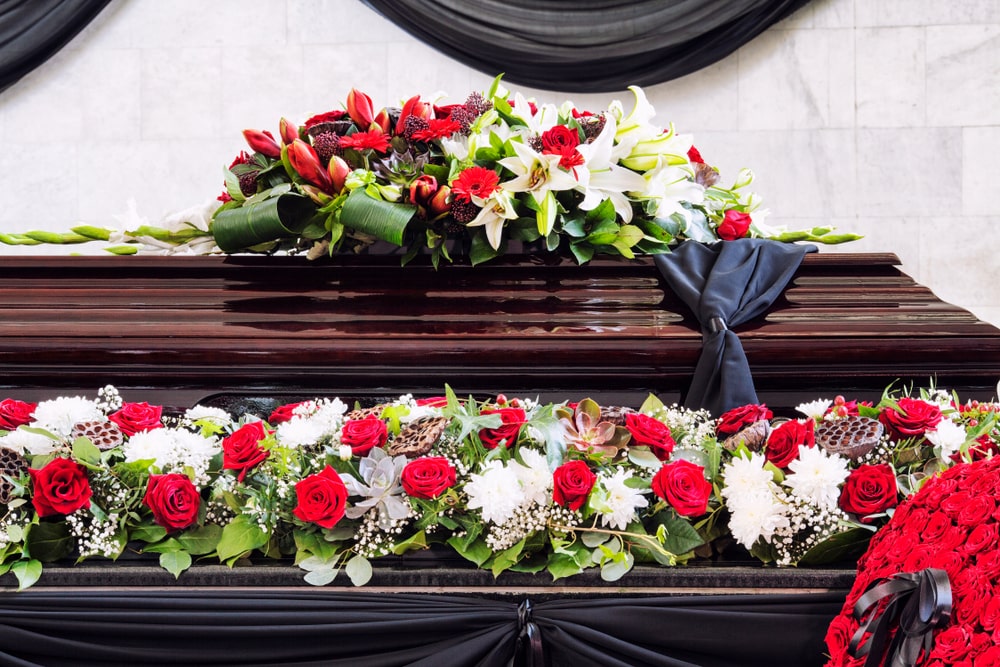
When planning a funeral service, the best way to create a truly unique, one-of-a-kind experience is to add personalized touches throughout the events. That might mean selecting special music, choosing a theme (like a certain color or pop culture reference), allowing family and friends to share memories, including hobby items or collectibles – there are so many options. But did you know that you can also personalize the casket itself? Let’s talk about 6 ways you can do it!

If you have a specific vision for the perfect casket, all you need to do is speak with your chosen funeral home about your ideas. Whether you’d like a specific color (like purple, pink, or even zebra) or you’d like a specific theme (like space, John Deere tractors, or unicorns), the funeral director can work with you to ensure that your preferences are accommodated. You can also request custom head panel or lining fabric to complete the personalization.
While the four-sided casket is the most popular choice in the United States, you can commission a specific shape. For instance, if you’d like a casket shaped like an M&M candy, a Viking longship, or even a pineapple, you can request it. Of course, it will take extra time and money to create a custom casket. With that in mind, speak with your funeral director to discuss the best way to move forward with a custom shape and how that may affect the timing of funeral services.

Another option for personalizing a casket is to add etchings or photos to it. While photos are somewhat self-explanatory (you choose the ones you want to include), etchings may require a little explanation. With etchings, you can include any type of symbol you want – religious symbols, pop culture references, crests, anything you wish. You will work closely with the funeral director as you create the perfect design for your custom casket.
If you are looking for a way to personalize the casket without putting in a custom order, you can! Because the casket often has space along the sides or at the foot, it’s possible to bury a loved one with meaningful possessions. For example, you can include photos, special mementos, jewelry, stuffed animals, and other small items. If the person was a firefighter, you could include their helmet or a flag from their station. If they were a veteran, you can include any medals or special honors they received.

When the casket is closed, you can always drape a casket blanket or flag over it to add personalization. A casket blanket is a beautifully designed floral arrangement that looks like a blanket and drapes over the casket. They are available in a variety of colors and create a truly stunning addition to the service. However, you can also use other items to drape over the casket. For example, you can drape a flag of any kind – an American flag, a sports team flag, an organization, etc. Also, if you’d like, you can also drape an actual blanket, like a quilt or throw. Whatever means the most to you and your family.
It’s quite common to accent a casket with a floral arrangement, but there are actually quite a few options to choose from. The casket blanket is one option, but you can also choose a casket spray, a floral garland, or a floral scarf.
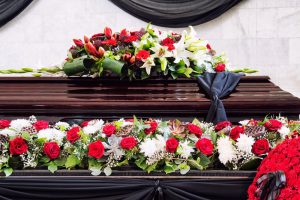
As you can see, there are quite a few options for personalizing a casket. All you have to do is determine which ones make the most sense for your loved one and fit into your budget. At a time of loss, many families end up “emotionally overspending,” so before you commit to anything, speak with your funeral director about pricing and options.
Also, a quick note, it is possible to plan ahead for funeral wishes, so if you do want something specific for your casket, you can write those specifications down and set aside funds to pay for it. Set up a consultation with a funeral professional to learn more about how planning ahead for funeral wishes not only gives your family peace of mind, but it also gives you the opportunity to make your personal wishes known!
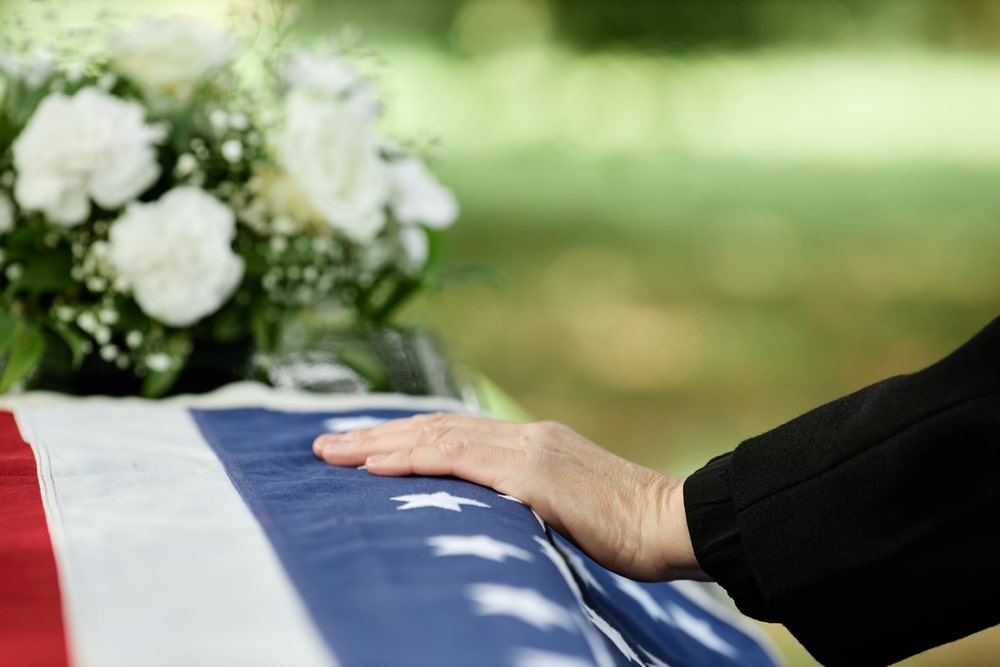
With so many benefits available to veterans, it’s hard to keep track of all of them. To help you out, here’s a list of frequently asked questions about burial benefits and their answers!
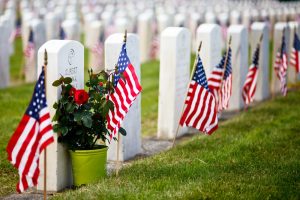
A: The Department of Veterans Affairs (VA) offers burial benefits for eligible veterans, their spouses, and their dependent children. These burial benefits include, at no cost to the family:
For more in-depth information about these benefits, contact your local VA office, go to www.benefits.va.gov, or speak with a funeral professional who is well-versed in veterans’ burial benefits.
A: The VA does not directly pay for funeral or burial/cremation expenses, such as the cost of a casket, embalming, cremation, viewing, flowers, obituaries, or transportation of the remains. However, the person who paid for the funeral expenses of a veteran may be eligible to apply for a reimbursement or “allowance” for a portion of the funeral and burial/cremation expenses. You will find instructions on how to apply for a reimbursement here.

A: The VA offers an allowance to cover a portion of funeral and burial/cremation costs. If a veteran dies due to a service-connected cause, the family of a veteran may be eligible for an allowance of up to $2,000. For a non-service-connected death, the VA will pay a specified amount to the family. Plot interment and burial/cremation and funeral allowance amounts are dependent on the date of death and whether or not the veteran was under VA hospital care at the time of death.
A: To receive VA burial benefits, you must be a veteran of the Armed Forces (Army, Navy, Air Force, Marine Corps, Coast Guard) with a discharge other than dishonorable. If a veteran has anything less than a general discharge, he or she may not qualify for burial benefits. Certain discharges other than honorable are considered on a case-by-case basis by the VA Regional Office to determine eligibility.
Reservists and National Guard members may qualify based on their retirement status and whether or not they died while on active duty or on official orders. Spouses and minor or disabled children of an eligible veteran may also be eligible for burial benefits. In some cases, parents of an eligible veteran may be eligible for burial benefits as well.
To determine your specific eligibility status, contact your VA Regional Office or visit www.cem.va.gov/cem/burial_benefits/eligible.asp for a complete list of eligibility requirements.
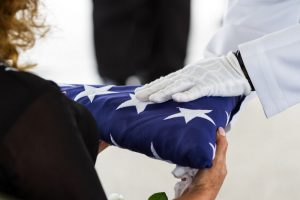
A: Burial benefits are available to eligible spouses and dependents who choose burial in a national cemetery. Benefits include burial with the veteran, perpetual care, and the spouse or dependent’s name and date of birth and death inscribed on the veteran’s headstone.
A: Once you have a funeral home partner, your funeral director will contact the honor guard to request military honors. At the committal service, the service member will present one burial flag to the next of kin. Make sure to let your funeral director know to whom the flag should be presented.
A: First, ensure that your family is aware of your veteran status and your desire for them to access your veterans’ burial benefits when you die. Second, to access your burial benefits, they will need a copy of your DD 214 form or an equivalent form. This form identifies the classification of discharge. If the DD 214 form is misplaced or lost, contact Veteran Affairs or your local Veteran Service Officer to request a replacement form. You can also find more information online here.

A: The main difference is that state governments manage state veteran cemeteries. However, in many cases, VA grants fund state veteran cemeteries, so they must adhere to federal eligibility requirements.
Burial benefits often include opening and closing of the grave, perpetual care, grave liner, and the setting of the government-furnished headstone or marker. Eligible veterans also receive one burial flag and a Presidential Memorial Certificate.
Please note, some state cemeteries may charge for interment of the veteran and eligible spouse or dependent children. Check with your funeral director to get more information about the state veteran cemeteries in your area.
A: Veterans buried in a private cemetery may be eligible to receive a government-furnished headstone, marker, or medallion, one burial flag, and Presidential Memorial Certificate, at no cost to the family. The VA will not pay for cemetery plots or opening and closing of graves at private cemeteries. However, your family can apply for a reimbursement (called an “allowance,” as mentioned above). Spouses and dependents buried in a private cemetery are not eligible to receive any VA benefits.
A: Eligible spouses and dependents may be buried in a national cemetery, even if they predecease the veteran. If you are interested in burial at a state veteran cemetery, contact the cemetery directly to find out their regulations on the burial of a non-veteran spouse or child.

A: For information on how to apply for a burial allowance or plot allowance, click here. If you would like to request burial in a national cemetery, the easiest thing is to let your funeral director know. They can take care of most details for you. However, if you’d like, you can contact the National Cemetery Administration directly at 800-698-2411 (TTY: 711).
A: Burials at Arlington National Cemetery are reserved for:
A: If a veteran dies as the result of a service-connected disability, is under VA care at the time of death, or is receiving a VA pension or compensation, some or all of the costs for transporting the veteran’s remains to a national cemetery may be reimbursed. The VA will advise the next of kin or person making the burial arrangements on this matter.
Hopefully, the answers to these frequently asked questions have helped you get a better understanding of the veterans’ burial benefits available through the Department of Veterans Affairs. But of course, should you have questions, don’t hesitate to reach out to the VA directly or contact a trusted funeral professional. Thank you for your service!